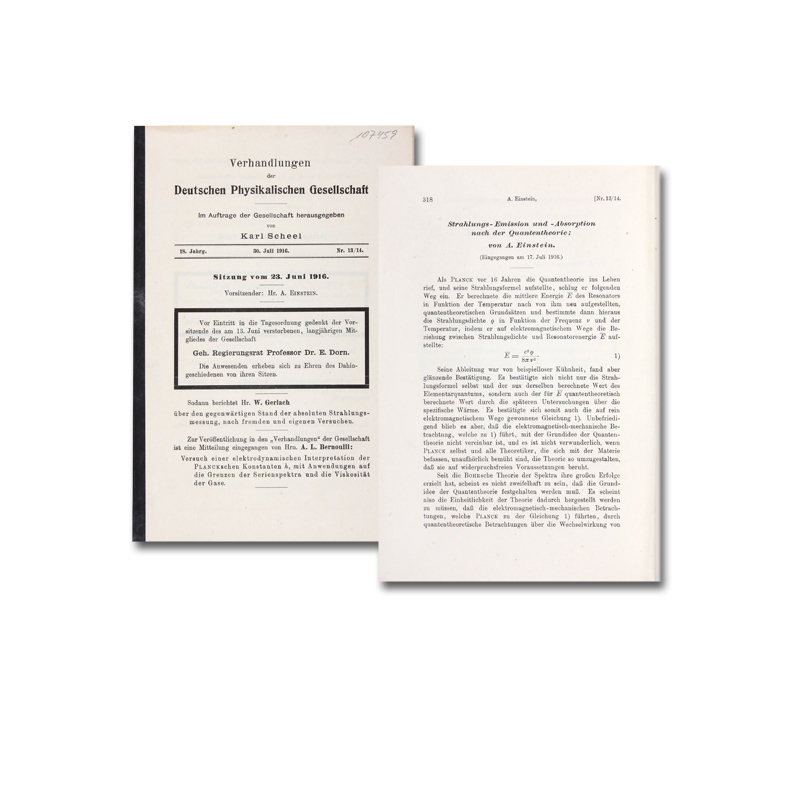107459-01
Strahlungs-Emission und -Absorption nach der Quantentheorie. SS. 318-323. In: Verhandlungen der Deutschen Physikalischen Gesellschaft. Jg. 18, Heft 13/14.
(Braunschweig, Vieweg), 1916. - (21,5 x 14,5 cm). SS. (315)-332. Mit Abbildungen. Rückenbroschur.
Erste Ausgabe dieser bedeutenden, von Weil mit einem Stern versehenen Arbeit. - "When Einstein returned to the radiation problem in 1916, the quantum theory had undergone a major change. Niels Bohr's papers had opened a new and fertile domain for the application of quantum concepts - the explanation of atomic structure and atomic spectra. In addition Bohr's work and its generalizations by Arnold Sommerfeld and others constituted a fresh approach to the foundations of the quantum theory of matter. Einstein's new work showed the influence of these ideas. He had found still another derivation of Planck's black-body radiation law, an 'astonishingly simple and general' one which, he thought, might properly be called 'the derivation' of this important law. It was based on statistical assumptions about the processes of absorption and emission of radiation and on Bohr's basic quantum hypothesis that atomic systems have a discrete set of possible stationary states. The proof turned on the requirement that absorption and emission of radiation, both spontaneous and stimulated, suffice to keep a gas of atoms in thermodynamic equilibrium. (This paper introduced the concept of stimulated emission into the quantum theory and is therefore often described as the basis of laser physics). Einstein himself considered the most important contribution of this work to be not the new derivation of the distribution law but rather the arguments he presented for the directional character of energy quanta. Each quantum of frequency Ny emitted by an atom must carry away momentum h x Ny/c in a definite direction; spherical waves would simply not exist. Although Einstein put particular emphasis on the directionality of light quanta, there was no direct evidence for it until 1923 when Arthur Compton explained his experiments on the increase in X-ray wavelength after scattering from free electrons. Compton simply treated the process as a collision, obeying the conservation laws, between the electron and a quantum of energy h x Ny and momentum h x Ny/c in the direction of the incident X-ray beam" (DSB). - Sauber und wohlerhalten. - DSB 4, 317; Weil 85*; Alicke, Einstein 76a
Strahlungs-Emission und -Absorption nach der Quantentheorie. SS. 318-323. In: Verhandlungen der Deutschen Physikalischen Gesellschaft. Jg. 18, Heft 13/14.
(Braunschweig, Vieweg), 1916. - (21,5 x 14,5 cm). SS. (315)-332. Mit Abbildungen. Rückenbroschur.
Erste Ausgabe dieser bedeutenden, von Weil mit einem Stern versehenen Arbeit. - "When Einstein returned to the radiation problem in 1916, the quantum theory had undergone a major change. Niels Bohr's papers had opened a new and fertile domain for the application of quantum concepts - the explanation of atomic structure and atomic spectra. In addition Bohr's work and its generalizations by Arnold Sommerfeld and others constituted a fresh approach to the foundations of the quantum theory of matter. Einstein's new work showed the influence of these ideas. He had found still another derivation of Planck's black-body radiation law, an 'astonishingly simple and general' one which, he thought, might properly be called 'the derivation' of this important law. It was based on statistical assumptions about the processes of absorption and emission of radiation and on Bohr's basic quantum hypothesis that atomic systems have a discrete set of possible stationary states. The proof turned on the requirement that absorption and emission of radiation, both spontaneous and stimulated, suffice to keep a gas of atoms in thermodynamic equilibrium. (This paper introduced the concept of stimulated emission into the quantum theory and is therefore often described as the basis of laser physics). Einstein himself considered the most important contribution of this work to be not the new derivation of the distribution law but rather the arguments he presented for the directional character of energy quanta. Each quantum of frequency Ny emitted by an atom must carry away momentum h x Ny/c in a definite direction; spherical waves would simply not exist. Although Einstein put particular emphasis on the directionality of light quanta, there was no direct evidence for it until 1923 when Arthur Compton explained his experiments on the increase in X-ray wavelength after scattering from free electrons. Compton simply treated the process as a collision, obeying the conservation laws, between the electron and a quantum of energy h x Ny and momentum h x Ny/c in the direction of the incident X-ray beam" (DSB). - Sauber und wohlerhalten. - DSB 4, 317; Weil 85*; Alicke, Einstein 76a
1.400 €

